A uniform cylinder of length (L) and mass (M) having cross sectional area (A) is suspended, with its length vertical, from a fixed point by a massless spring, such that it is half - submerged in a liquid of density (rho) at equilibrium position. When the cylinder is given a small downward push and released it starts oscillating vertically with small amplitude. If the force constant of the spring is (k), the prequency of oscillation of the cylindcer is.
12π(k−AρgM)1/2
12π(k+AρgM)1/2
12π(k+ρ−gLM)1/2
12π(k+A−ρgM)1/2
The correct Answer is:B
To solve the problem step by step, we will analyze the forces acting on the cylinder and derive the frequency of oscillation.
Step 1: Analyze the Forces at Equilibrium
At the equilibrium position, the forces acting on the cylinder are:
- The weight of the cylinder W=Mg acting downward.
- The buoyant force Fb acting upward.
According to Archimedes' principle, the buoyant force is equal to the weight of the liquid displaced by the submerged part of the cylinder.
Step 2: Calculate the Buoyant Force
The volume of the submerged part of the cylinder is given by:
V=cross-sectional area×height submerged=A×L2
Thus, the buoyant force can be expressed as:
Fb=density of liquid×gravity×volume=ρg(AL2)
Step 3: Set Up the Equilibrium Condition
At equilibrium, the buoyant force equals the weight of the cylinder:
Fb=W⟹ρg(AL2)=Mg
We can simplify this equation by canceling g from both sides:
ρAL2=M
Step 4: Analyze the Oscillation
When the cylinder is pushed down by a small distance x and released, the forces acting on it will be:
- The weight Mg acting downward.
- The buoyant force Fb acting upward, which now changes because the submerged volume increases.
- The spring force Fs=kx acting upward.
The new buoyant force when the cylinder is displaced by x becomes:
F′b=ρg(A(L2+x))=ρgA(L2+x)
Step 5: Write the Equation of Motion
The net force acting on the cylinder when displaced by x is:
Fnet=F′b−Mg−kx
Substituting the expressions we have:
Fnet=ρgA(L2+x)−Mg−kx
Using the equilibrium condition ρgAL2=Mg, we can simplify:
Fnet=ρgAx−kx
This can be rearranged as:
Fnet=(ρgA−k)x
Step 6: Apply Newton's Second Law
According to Newton's second law, F=ma:
Md2xdt2=(ρgA−k)x
This is a standard form of simple harmonic motion, where:
d2xdt2+(ρgA−k)Mx=0
From this, we can identify the angular frequency ω:
ω2=k+ρgAM
Step 7: Calculate the Frequency of Oscillation
The frequency f is given by:
f=ω2π=12π√k+ρgAM
Final Answer
Thus, the frequency of oscillation of the cylinder is:
f=12π√k+ρgAM
At the equilibrium position, the forces acting on the cylinder are:
- The weight of the cylinder W=Mg acting downward.
- The buoyant force Fb acting upward.
The volume of the submerged part of the cylinder is given by:
V=cross-sectional area×height submerged=A×L2
Thus, the buoyant force can be expressed as:
Fb=density of liquid×gravity×volume=ρg(AL2)
At equilibrium, the buoyant force equals the weight of the cylinder:
Fb=W⟹ρg(AL2)=Mg
We can simplify this equation by canceling g from both sides:
ρAL2=M
When the cylinder is pushed down by a small distance x and released, the forces acting on it will be:
- The weight Mg acting downward.
- The buoyant force Fb acting upward, which now changes because the submerged volume increases.
- The spring force Fs=kx acting upward.
F′b=ρg(A(L2+x))=ρgA(L2+x)
The net force acting on the cylinder when displaced by x is:
Fnet=F′b−Mg−kx
Substituting the expressions we have:
Fnet=ρgA(L2+x)−Mg−kx
Using the equilibrium condition ρgAL2=Mg, we can simplify:
Fnet=ρgAx−kx
This can be rearranged as:
Fnet=(ρgA−k)x
According to Newton's second law, F=ma:
Md2xdt2=(ρgA−k)x
This is a standard form of simple harmonic motion, where:
d2xdt2+(ρgA−k)Mx=0
From this, we can identify the angular frequency ω:
ω2=k+ρgAM
The frequency f is given by:
f=ω2π=12π√k+ρgAM
Thus, the frequency of oscillation of the cylinder is:
f=12π√k+ρgAM
Topper's Solved these Questions
- BOOK - CENGAGE PHYSICS ENGLISHCHAPTER - ARCHIVES 2 VOLUME 6EXERCISE - Multiple Correct22videos
ARCHIVES 2 VOLUME 6
- BOOK - CENGAGE PHYSICS ENGLISHCHAPTER - ARCHIVES 2 VOLUME 6EXERCISE - Comprehension12videos
ARCHIVES 2 VOLUME 6
- BOOK - CENGAGE PHYSICS ENGLISHCHAPTER - ARCHIVES 2 VOLUME 6EXERCISE - True/False4videos
ARCHIVES 2 VOLUME 6
- BOOK - CENGAGE PHYSICS ENGLISHCHAPTER - ARCHIVES 1 VOLUME 6EXERCISE - Integer4videos
ARCHIVES 1 VOLUME 6
- BOOK - CENGAGE PHYSICS ENGLISHCHAPTER - BASIC MATHEMATICSEXERCISE - Exercise 2.620videos
BASIC MATHEMATICS
Similar Questions
A uniform cylinder of length L and mass M having cross-sectional area A is suspended, with its length vertical, from a fixed point by a massless spring such that it is half submerged in a liquid of density σ at equilibrium position. The extension x0 of the spring when it is in equlibrium is:
View SolutionA rod of length L, cross sectional area A and density ρ is hanging from a rigid support by spring of stiffries k. A very small sphere of mass m is rigidly attached at the bottom of the rod. The rod is partially immersed in a liquid of density ρ. Find the period of small oscillations.
View Solution
Knowledge Check
- Question 1 - Select One
A uniform cylinder of length L and mass M having cross-sectional area A is suspended, with its length vertical, from a fixed point by a massless spring such that it is half submerged in a liquid of density σ at equilibrium position. The extension x0 of the spring when it is in equlibrium is:
AMgk(1+LaσM)BMgkCMgk(1+LaσM)DMgk(1−Laσ2M) - Question 2 - Select One
A particle of mass m is hanging vertically by an ideal spring of force constant K . If the mass is made to oscillate vertically, its total energy is
Amaximum at the extreme positionBmaximum at the mean positionCminimum at the mean positionDsame at all positions.
A uniform cylinder of mass m and radius R is in equilibrium on an inclined by the action of a light spring of stiffnesk, gravity and reaction force acting on it .If the angle of inclination of the plane is ϕ , find the angular frequency of small oscillation of the cylinder
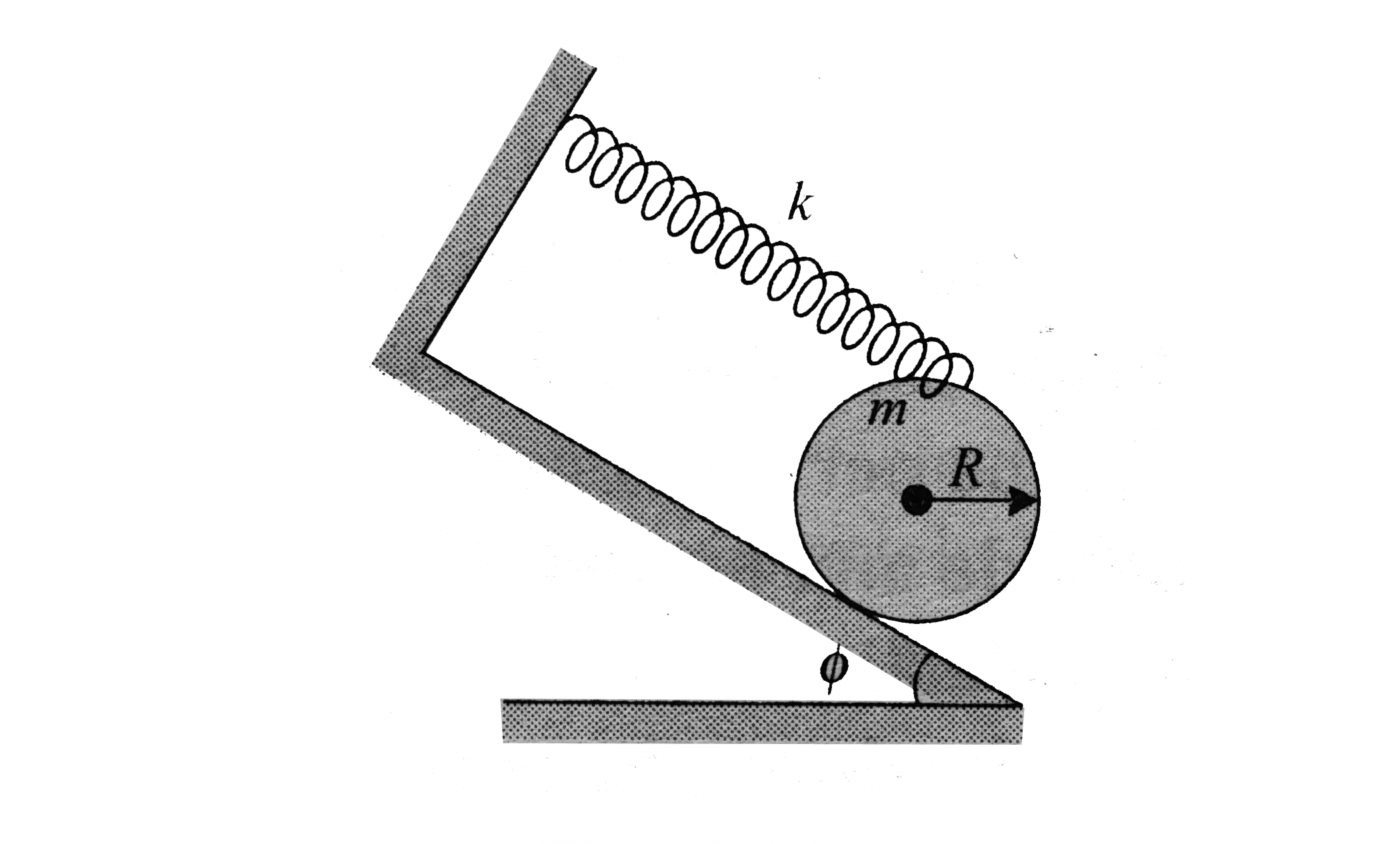 View Solution
View SolutionA solid cylinder of mass M=10kg and cross - sectional area A=20cm2 is suspended by a spring of force contant k=100N/m and hangs partically immersed in water. Calculate the period of small oscillation of the cylinder.
View SolutionA rod of length l and mass m, pivoted at one end, is held by a spring at its mid - point and a spring at far end. The spring have spring constant k. Find the frequency of small oscillations about the equilibrium position.
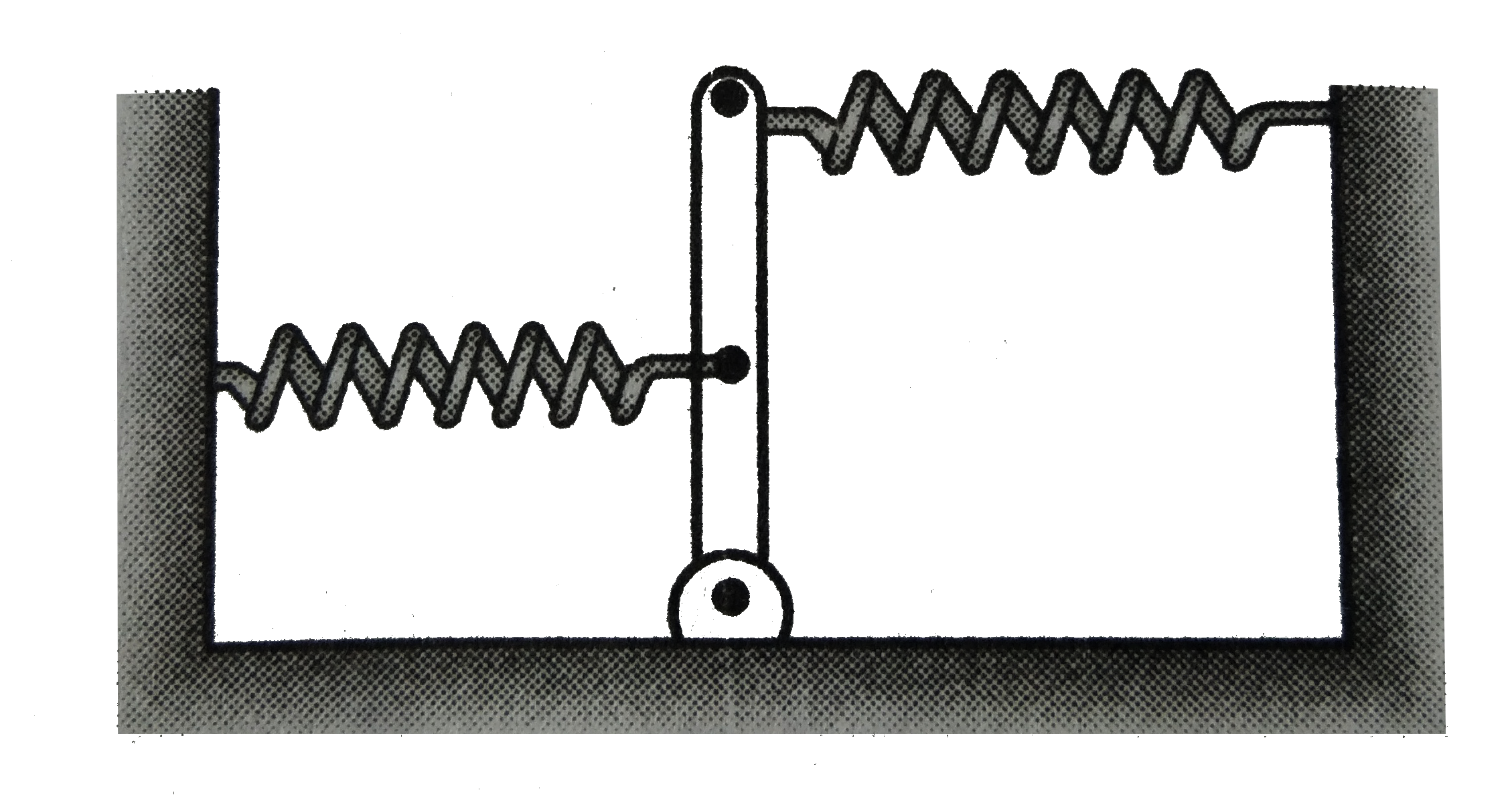 View Solution
View SolutionA system shown in the figure consists of a massless pulley, a spring of force constant k displaced vertically downwards from its equilibrium position and released, then the Period of vertical oscillations is
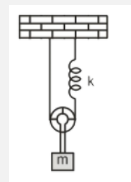 View Solution
View SolutionA vertical pole of length l , density ρ , area of cross section A floats in two immiscible liquids of densities ρ1and ρ2. In equuilibrium possition the bottom end is at the interface of the liquids. When the cylinder is displaced vertically, find the time period of oscillation.
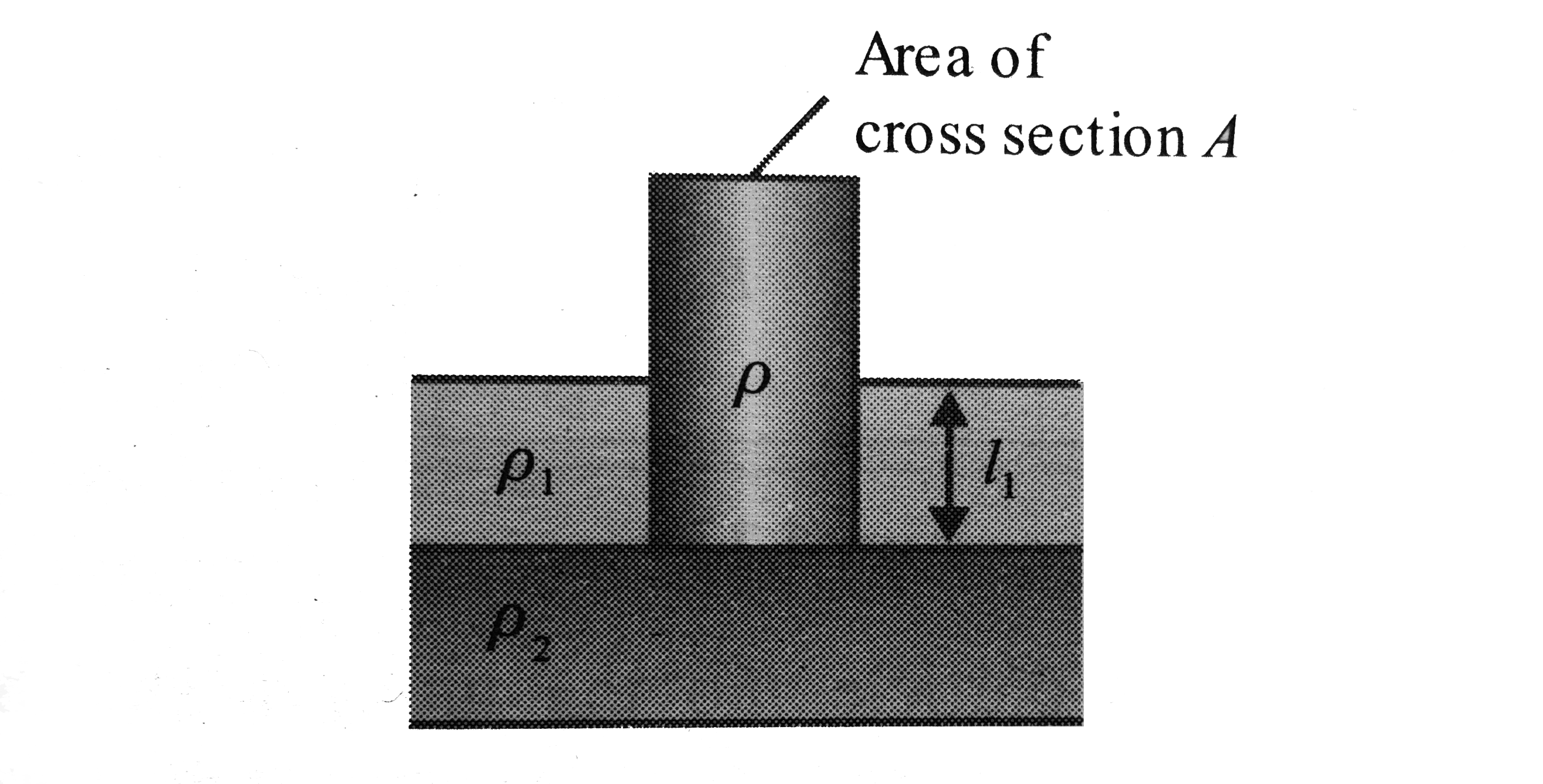 View Solution
View Solution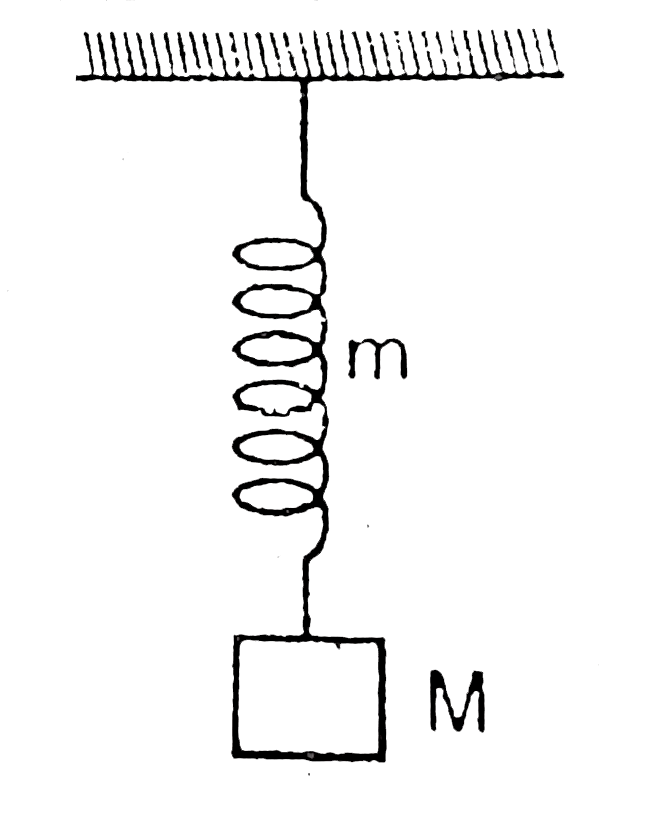
A block of M is suspended from a vertical spring of mass m as shown in the figure. When block is pulled down and released the mass oscillates with maximum velocity v.View Solution

